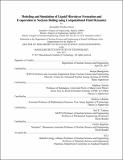| dc.contributor.advisor | Jacopo Buongiorno, Stéphane Zaleski, and Shahriar Afkhami. | en_US |
| dc.contributor.author | Guion, Alexandre Nicolas | en_US |
| dc.contributor.other | Massachusetts Institute of Technology. Department of Nuclear Science and Engineering. | en_US |
| dc.date.accessioned | 2017-12-05T16:25:22Z | |
| dc.date.available | 2017-12-05T16:25:22Z | |
| dc.date.copyright | 2017 | en_US |
| dc.date.issued | 2017 | en_US |
| dc.identifier.uri | http://hdl.handle.net/1721.1/112380 | |
| dc.description | Thesis: Ph. D., Massachusetts Institute of Technology, Department of Nuclear Science and Engineering, 2017. | en_US |
| dc.description | This electronic version was submitted by the student author. The certified thesis is available in the Institute Archives and Special Collections. | en_US |
| dc.description | Cataloged from student-submitted PDF version of thesis. | en_US |
| dc.description | Includes bibliographical references (pages 243-252). | en_US |
| dc.description.abstract | The transport of latent heat makes boiling one of the most efficient modes of heat transfer, allowing a wide range of systems to improve their thermal performance, from microelectronic devices to nuclear power plants. In particular, Boiling Water Reactors (BWR) use boiling as the primary mode of heat transfer in the reactor core to accommodate very high heat fluxes. In Pressurized Water Reactors (PWR) subcooled flow boiling can occur in hot sub-channels. As a bubble grows outside of a surface imperfection during nucleate boiling, viscous stresses at the wall can be strong enough to impede liquid motion and trap a thin liquid layer - referred to as microlayer, underneath the growing bubble. The contribution of microlayer evaporation to overall heat transfer and bubble growth can be large, in particular in the case of water1. In practice, numerical simulations of nucleate boiling resolve the macroscopic interface of the bubble and resort to subgrid models to account for the evaporation of the microlayer at the microscopic scale. The applicability of this subgrid modeling approach relies on the capacity to initialize the microlayer shape and extension, prior to its evaporation. However, existing models of microlayer formation are either physically incomplete2 or purely empirical3. In this work, we first confirm through a sensitivity study the need for accurate modeling of microlayer formation to initialize boiling simulations and to reproduce physical boiling dynamics (a). Then, we build the first generally applicable model for microlayer formation through direct computations of the hydrodynamics of bubble growth at the wall for a wide range of conditions and fluids, including water at 0.101MPa (lab experiments) and 15.5MPa (PWR), capillary numbers Ca [is element of] [0.001; 0.1], and contact angles [theta] [is element of] [10°; 90°] (b). In addition, we modify an existing experimental pool boiling setup to measure with unprecedented accuracy initial bubble growth rates needed to predict microlayer formation (c). Lastly, we develop a numerical procedure based on hydrodynamics theories to obtain mesh-independent results in moving contact line simulations for a wide range of contact angles and viscosity ratios (d). In particular, we use direct computations of the transition to a Landau-Levich-Derjaguin film in forced dewetting to inform the onset of microlayer formation in nucleate boiling. These contributions(a) (b) (c) (d) bridge a significant gap in our understanding of how boiling works and can be modeled at the microscopic scale, which represents a first step in designing surfaces with higher heat transfer performance and in building safer and more efficient energy systems. | en_US |
| dc.description.statementofresponsibility | by Alexandre Nicolas Guion. | en_US |
| dc.format.extent | 252 pages | en_US |
| dc.language.iso | eng | en_US |
| dc.publisher | Massachusetts Institute of Technology | en_US |
| dc.rights | MIT theses are protected by copyright. They may be viewed, downloaded, or printed from this source but further reproduction or distribution in any format is prohibited without written permission. | en_US |
| dc.rights.uri | http://dspace.mit.edu/handle/1721.1/7582 | en_US |
| dc.subject | Nuclear Science and Engineering. | en_US |
| dc.title | Modeling and simulation of liquid microlayer formation and evaporation in nucleate boiling using computational fluid dynamics | en_US |
| dc.type | Thesis | en_US |
| dc.description.degree | Ph. D. | en_US |
| dc.contributor.department | Massachusetts Institute of Technology. Department of Nuclear Science and Engineering | |
| dc.identifier.oclc | 1011423203 | en_US |
